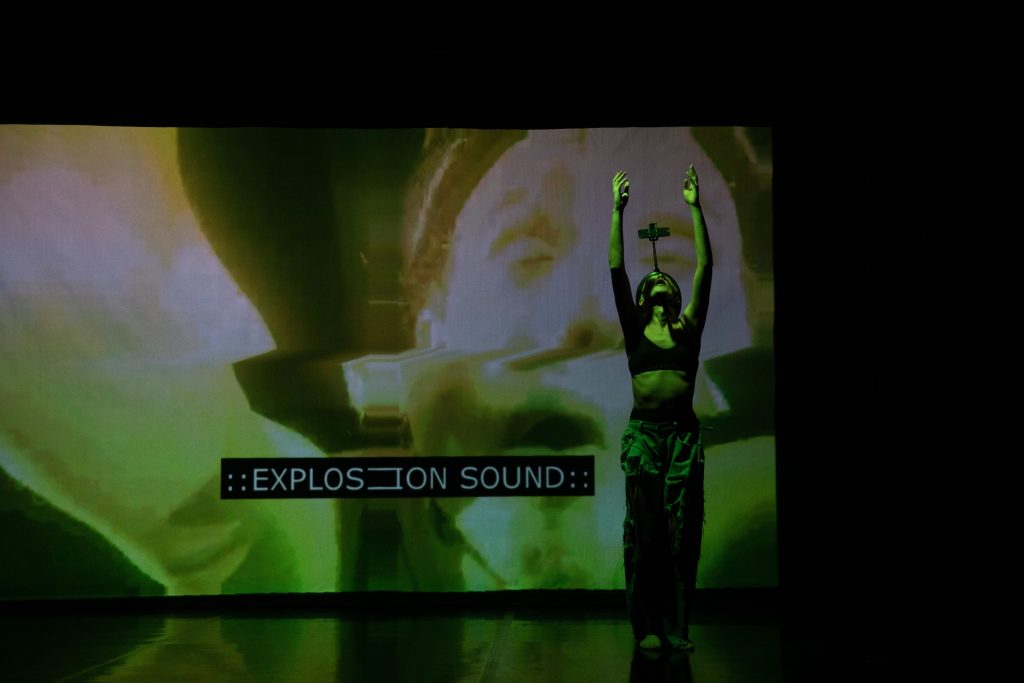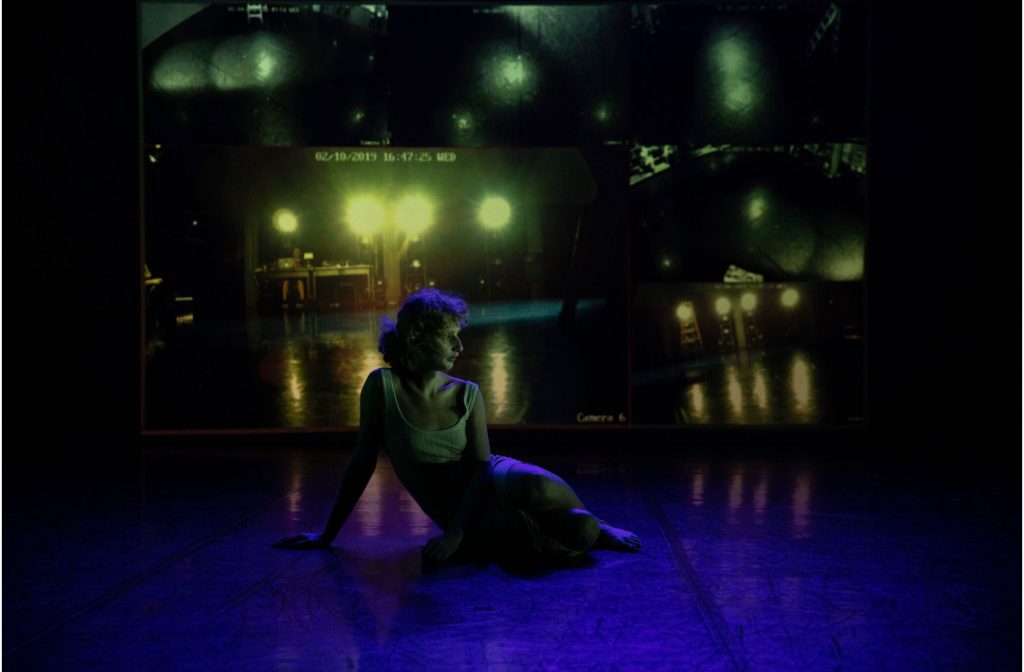Take what’s going to make you choke and turn it into a joke.
Ita Segev uttered the sentence with an unsettling casualness. Lit in a green spotlight, her body shifted back and forth to the percussive rhythm of the sound score; her voice was heavily distorted; her face was live-projected on the back wall using a small camera attached to the helmet she was wearing. She proceeded to tell a story about an Israeli friend she knew from combat training, nicknamed Mr. Coca-Cola because his dick was as thick as the beverage can.
Mr. Coca-Cola went into Gaza, not the “surfing-on-the-beach” Gaza but the “Gaza Gaza.” One time his commander directed him to fire a missile toward a residential building from which gunshots were coming. As Mr. Coca-Cola was quoted comparing his time fighting in Gaza to raving in the club, the percussion accelerated in pace and escalated in intensity to the point where it exploded into silence, mirroring the explosion of the building. Segev slowly took off the helmet, letting the silence stretch while the audience waited for the punchline.
Not that building you idiot! The one to the left!
With a grand arm gesture and a big smile on her face, Segev exclaimed as the commander. Laughter wanted to erupt among the audience members, but failed to materialize. An air of discomfort thickened. The punchline subverted its conventional function as a release valve, twisting the narrative into a knot as it was about to resolve. I chuckled nervously, which felt kind of wrong at the moment, although I certainly was not the only one to. Should we laugh in the wake of the Palestinian death caused by that senseless missile? The easy answer is no, we shouldn’t. And yet, laughter seemed the only appropriate response. How else can we react to the absurdity of a missile flying into the wrong building, just because it can? Not to mention the fact that Segev’s delivery was undeniably funny: the low camera angle, the blown-up selfie projection, Segev’s squinted eyes with exaggerated facial expressions, her sing-songy cadence, her sensual movements, all of which invited us to take the violence of war not too seriously, to taste it more viscerally.
This short vignette was taken from “Knot In My Name:” an evening-length performance work created by Ita Segev. Its official premiere was at Gibney Dance Center in October 2019, although I had the pleasure of following the work’s development and seeing its many early iterations during the year before that. In general, the piece weaved together multiple (inter)personal narratives that were broadly rooted in the contexts described on the Center’s website as “an anti-Zionist Israeli trans woman immigrating to the U.S.” This socio-political positioning was clear from the beginning of the work, along with its imperative to relay her collective memories to the audience members through the craft of storytelling—a seemingly straightforward practice. However, as we, the audience, became implicated in these intersecting histories, the clarity of identity categories began to loosen, unraveling the messiness and disorientation of the traumatic episodes that altogether mark Segev under the signifiers “trans woman” and “anti-Zionist Israeli.”
Episodes followed one after another in no linear order, although the performance did open with a video and a poem that imagined the start of it all, before the fantasy of origin that not only preconditions our sense of being but also justifies violence against others. Before the doctor called me boy, and the state called my birthplace Israel… The before that could no longer be, that one could only drool after and chase endlessly without resolution — a melancholic longing for an impossible world untouched by origin stories.
Nonetheless, Segev’s yearning for a past beyond the “original” past did not dwell in the internal and cyclical sense of loss often associated with melancholy. Before all these words, there was silence, I think. But I will never know for certain so I will speak. The silence before the words was not a point of fixation but served as a positive and urgent reminder that different worlds had existed, and therefore the one given to us could be imagined and transformed otherwise. As we moved through “Knot In My Name,” this determination to speak became apparent with the excessive mobilization of characters, costumes, music, and cameras that contrasted the quiet beginning. In a way, the opening poem foreshadowed a melancholic undercurrent that bubbled below the humor and high-energy storytelling throughout, revealing the affective complexity with which the work approached issues of identity and trauma.
Segev overwhelmed us with abrupt transitions between scenes. From embodying her great-great-…-great grandmother, who passes down the gift of transsexualism, to parodying the heterosexual fantasy in the movie Notting Hill, from hosting the fictional TV show Good Morning AmeriCunt to re-enacting some of her personal anecdotes in the Israeli army, the performer seamlessly morphed from one character to another to deliver divergent and contradictory content. One moment Segev wore sexually suggestive clothes yelling “You have a cunt! You have a cunt! You have a cunt,” alluding to Oprah Winfrey; the next she was in a white wedding dress, walking very slowly off-stage with one of the assistants’ half-naked body draped over her shoulder. It was impossible to feel either settled within a certain scene or to anticipate what would follow. As an audience member, I was kept alert at all times, for the narrative constantly undermined itself before a sense of familiarity and routine could set in.
Even though Segev’s ability to switch effortlessly demonstrated a virtuosic command over the fragmented stories as well as her own body, the performer’s chameleon-like transformations were extremely ominous. Many times as she was still speaking and trying to finish one scene, two assistants appeared out of nowhere and changed her costumes in an efficient task-like manner that felt mechanical and somewhat aggressive. Segev’s body felt seized, not only by the assistants but also by the several cameras discreetly preset in the performance space, incessantly feeding her image to the larger-than-life projection in the background.
As much as her movement was subjected to intense scrutiny and surveillance, Segev also used this hypervisibility to her full advantage. By mobilizing the multiple cameras at a dizzying pace, she constantly surprised the audience members with different perspectives and disoriented them with different forms of address in the narrative, further contributing to the piece’s feeling of fragmentation and overwhelming. There was an uncanny ambiguity between the forceful manipulation of her body and Segev’s skillful manipulation of the manipulation. Here, the hypervisibility of her trans-feminine body was both an externally imposed condition and a source of raw material for potential experimentation. Either way, her body was never at rest, caught within an endless confrontation with the origin stories of both Zionism and the gender binary, generating more knots than resolution.
Perhaps, it was this tirelessness that made “Knot In My Name” feel more populated than a solo. The piece never felt confined within the realm of the individual — even Segev’s extremely personal stories had such a sense of expansiveness that they always gestured toward larger collective histories. The personal was political, yes, and it was also funny, sexy, captivating, depressing, traumatic, and hopeful. It is easy for the writing to give too much weight to the content, while in performance it was really the affect that fueled the urgency of the work. I walked out of the theater overwhelmed and disoriented, unsure how to put into words my visceral experience of Segev’s trans-feminine and anti-Zionist narrative, but certain that something in me had been transformed.


